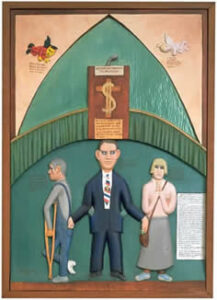 CARTLEDGE, NED
CARTLEDGE, NED
(1916–2001)
was a prolific, selftaught artist from Atlanta, best known for his satiric and provocative painted wood-relief carvings, infused with liberal political and socialcommentary. For more than forty years this dignified, mild-mannered, highly principled man expressed his disdain for racism, political corruption, mendacity, hypocrisy,and injustice with incisive wit, and challenged the social conscience of his audience through his carvings. His concerns extended beyond America’s borders to the globalissues of hunger and nuclear holocaust.Carving began as a hobby for Cartledge when he was a boy growing up in the Georgia communities of Canon and Austell. He attended public schools in Atlanta,completed one year of law school, then worked for many years for a cotton merchandising firm, later as a cotton broker, and finally as a hardware salesman. Cartledgeserved in the 89th Chemical Mortar Battalion during World War II and witnessed the horror of a liberated concentration camp at Woebbelin, Germany. His wartimeexperiences reinforced his social conscience, but it was not until the mid-1960s and his development of opposition to the war in Vietnam that Cartledge began to focuson political themes. In
Uncle Samson
(1966), his first political piece, Uncle Sam is metaphorically represented as destroying the United States.Most of Cartledge’s carvings are bas-relief and painted in acrylics or oils. He carved in various types of wood, depending on their availability, but preferred pine, poplar, and basswood. He also created some sculptural works as well as paintings. The American flag, Uncle Sam, doves, and bulls are recurrent motifs in Cartledge’swork, and he often used text or descriptive titles to enhance his visual commentary. In
One of Our Leading Economic Indicators
(1982), in which Cartledge portraysa homeless man wrapped in
The Wall Street Journal while
lying on the sidewalk facing an empty brick wall, he points out the social inequities among people. In oneof his most controversial carvings,
Garden of Eden
(1979), Cartledge shows a naked couple expelled by a black female God who is wearing a Star of Davidnecklace. Paradise is framed by a white picket fence, and a television set with a Coca-Cola logo on the screen is centrally positioned. Eight one-man exhibitions of Cartledge’s work were organized: in 1979, 1985, 1987, 1988, 1989, 1991–1992, 1993, and 1994.
See also
Sculpture, Folk
.
BIBLIOGRAPHY
Cartledge, Ned, and Robert F.Westervelt.
Ned Cartledge.
Atlanta, Ga., 1986.Muller Joan.
Under the Cloak of Justice: The Work of Ned Cartledge.
Richmond, Va., 1994. ——.“Ned Cartledge: Under the Cloak of Justice.”
Folk Art Messenger,
vol. 7, no. 1 (fall 1993): 10–11
